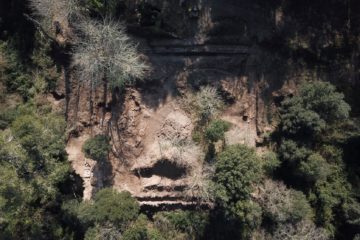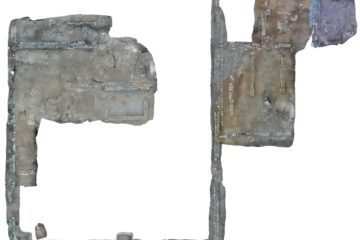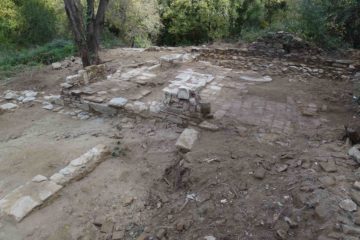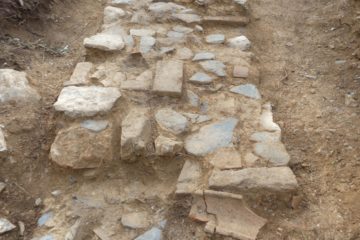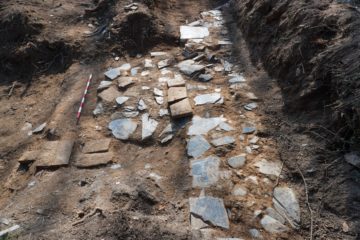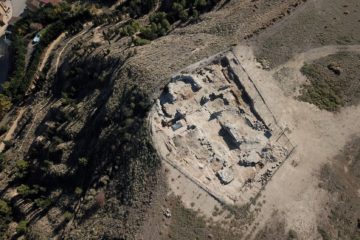Site: Royal Palace of Valldaura (Cerdanyola del Vallès, Vallès Occidental).
Campaigns: 2018 to present.
Directors: Maria Soler, Walter Alegría, Marta Sancho.
Heritage project: Vicente Guallart
Coordinates: 426938, 4589148 (UTM31N – ETRS89)
Location and initial situation:
The Royal Palace of Valldaura is located in the municipality of Cerdanyola del Vallès (Vallès Occidental), in the so-called Sot de Valldaura, on the northern slope of the Collserola mountain range, under the pass known as Pas del Rei and the border with the municipality of Barcelona. It has an altitude of 225 m above sea level and an irregular altimetry with a rich and lush vegetation.
The site is located in a space owned by the Institut d’Arquitectura Avançada de Catalunya (IAAC). The interest of this institution to increase knowledge about the richness of its heritage motivated the start of its own historical-heritage project, coordinated by the architect Vicente Guallart, who in 2011 commissioned geo-radar prospecting work that allowed to detect a series of subsoil structures.
The interest of the site and the documented remains encouraged that in 2017 a collaboration agreement was signed between the IAAC and the University of Barcelona, with the aim of promoting archaeological actions at the site. Since 2018 the research is integrated within the archaeological research project “Castles, monasteries and palaces. Power, territory and landscape (12th-17th centuries)”, funded by the Department of Culture of the Generalitat de Catalunya and IAAC.
Brief history:
The historical trajectory of the site begins in the middle of the 12th century, with the construction of what was the first Cistercian monastery in Catalan territory: Santa Maria de Valldaura. It was built on land ceded in 1150 by the Montcada family in the Occitan monastery of the Gran Selva, located near Toulouse de Languedoc. We know that six years later it was already functioning as a monastery, but circa 1169 it was transferred to the new and definitive foundation of Santes Creus.
It having been exploited by the Cistercians as a farm until the end of the 13th century, a Royal Palace was built, dedicated to the recreation, hunting and rest of the Catalan monarchs. It was for King James II, who resided there with his family for long periods. But also for his successors, from Alfonso the Gentle to Martin the Humane. Throughout the Middle Ages, the Royal Palace was ceded to various beneficiaries, who were obliged to have it ready to house the monarch and his entourage.
With the arrival of the Trastámara family, the house went into a deep decline. Neither Ferdinand of Antequera nor Alfonso the Magnanimous frequented it, until John II sold it. From that moment on, the Valldaura estate became a private property outside the royal will. Little by little, the medieval remains of the old Monastery and Palace of Valldaura disappeared. In the mid-nineteenth century the buildings were dismantled and many of the ashlars were used for the construction of the Can Valldaura Nou farmhouse, which now houses the headquarters of the IAAC.
Archaeological interventions:
The archaeological excavations began in 2018, through a collaboration agreement between IAAC and the University of Barcelona, which was later integrated within the project “Castles, Monasteries and Palaces. Power, Territory and Landscape (12th-17th centuries)” funded by the archaeological research program of the Generalitat de Catalunya and the IAAC.
Archaeological excavations carried out at the site have allowed us to document the structures corresponding to the Royal Palace of Valldaura, which is framed by a perimeter wall of 31 x 31 m built during the late Middle Ages with local stone and lime mortar. This enclosure integrates various reforms that fossilize the central enclosed space, while extending it with a terrace in the northeast and a farmhouse in the southeast end. It is very likely that these modern structures are resting on earlier remains from the medieval period.
BIBLIOGRAPHY
CATALÀ ROCA, Pere; BRASÓ I VAQUÉS, Miquel: “La Casa Reial de Valldaura”, Els castells catalans, vol. I. Barcelona, Rafael Dalmau, 1967, p. 548-552.
FORT I COGUL, Eufemià: “Los pergaminos de Valldaura-Santes Creus en el AHNM”, Studia Monastica, 8-2 (1966), p. 295-312.
MADURELL MARIMON, José M.: “El Monasterio de Santa Maria de Valldaura del Vallès (1150-1179)”, Analecta Sacra Tarraconensia, 25 (1953), p. 115-163.
MADURELL MARIMON, José M.: “Els reis de Catalunya-Aragó i la casa reial de Valldaura”, Estudis d’Història Medieval, 2 (1970), p. 45-67.
SÁNCHEZ, Miquel: El Cister: i al principi fou Valldaura. Santa Maria de Valldaura, 1150-1169. Valls, Cossetània Edicions, 2001.
SÁNCHEZ, Miquel: Història de Cerdanyola: dels orígens al segle XX. Cerdanyola del Vallès, Montflorit, 2005.
